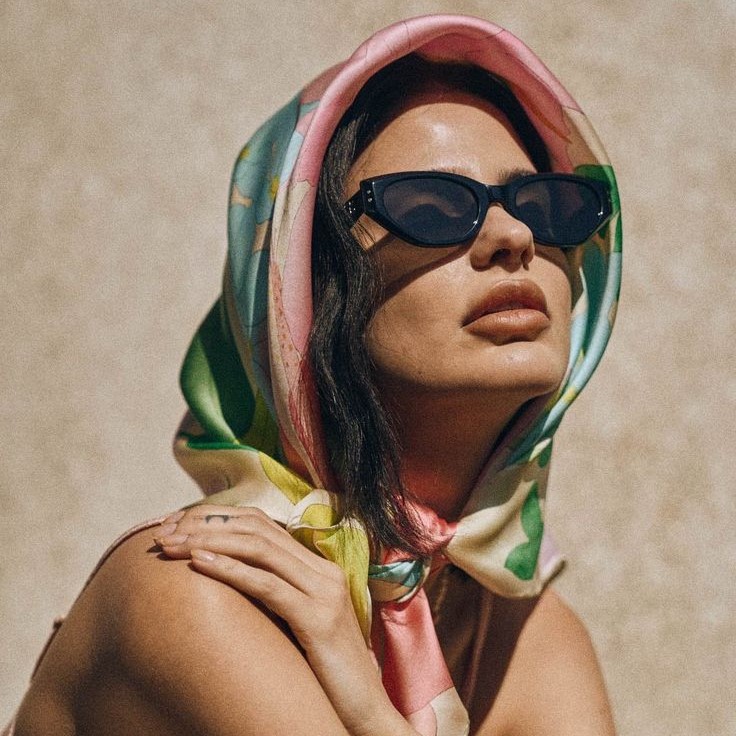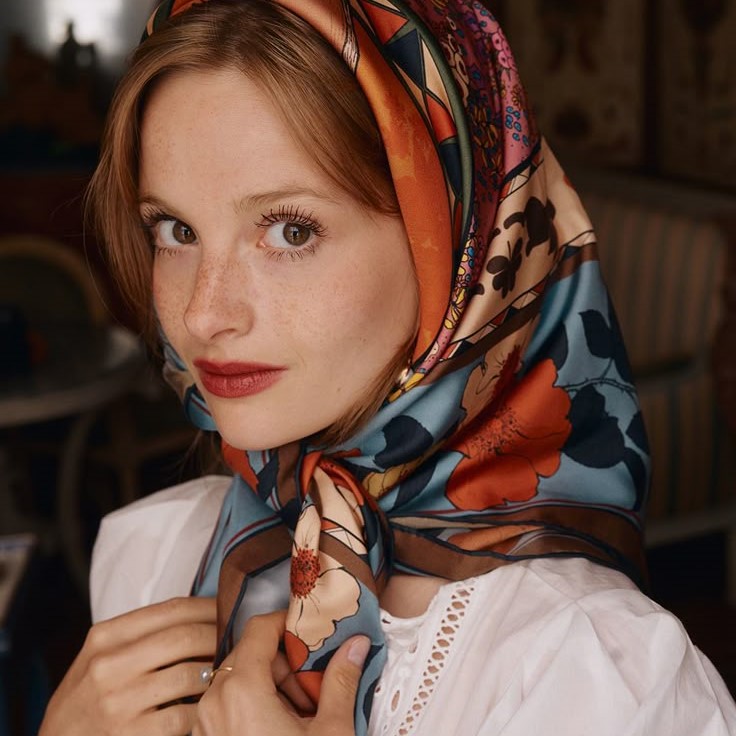Introduction
Silk head scarves are not only a timeless fashion accessory but also a practical one. They can add a touch of elegance to any outfit while providing essential protection for your hair. Whether you’re looking to elevate your style or keep your hair in top condition, learning how to wear silk head scarves is a skill worth mastering. In this guide, we’ll explore various ways to style these versatile accessories, their benefits, and answer common questions like “Is wearing a silk scarf good for your hair?”

The Benefits of Wearing
Why Choose Silk?
Silk is a luxurious fabric that offers numerous benefits. It is soft, smooth, and gentle on the skin and hair. Unlike other materials, silk does not cause friction, which means it reduces hair breakage and tangles. Additionally, silk retains moisture, helping to keep your hair hydrated and healthy. This makes silk head scarves an excellent choice for those who want to protect their hair while looking stylish.
Hair Protection
One of the primary reasons people choose silk head scarves is for hair protection. Silk’s natural properties help prevent split ends and reduce frizz. By wrapping your hair in a silk scarf, you create a barrier against environmental elements such as dust, wind, and sun. This is especially beneficial for individuals with delicate or damaged hair. Moreover, silk scarves can be worn overnight to protect your hair from pillow friction, ensuring you wake up with smooth, manageable locks.
How to Style Silk Head Scarves
Classic Wrap
- Preparation and Folding: Begin by folding the silk scarf into a triangle. This creates a versatile shape that can be easily adjusted to fit your head.
- Positioning the Scarf: Place the longest edge of the triangle at the nape of your neck, ensuring it is centered and even on both sides.
- Bringing the Corners Forward: Take the two corners of the triangle and bring them forward, crossing them over each other in front of your face.
- Tying the Knot: Securely tie the two corners under your chin. The knot should be tight enough to hold the scarf in place but not so tight that it causes discomfort.
- Tucking the Remaining Corner: Finally, take the remaining corner (the tip of the triangle) and tuck it into the back of the wrap. This helps to create a smooth and polished look.
- Versatility: The classic wrap is suitable for both casual and formal occasions. It adds a touch of elegance and sophistication to any outfit, making it a go-to style for many.
Turban Style
- Laying the Scarf Flat: Start by laying the silk scarf flat on a surface. This ensures that the fabric is smooth and free of wrinkles.
- Placing the Scarf Over Your Head: Position the middle of the scarf at the nape of your neck, with the ends hanging down in front of you. Make sure the scarf is evenly distributed on both sides.
- Crossing the Ends: Then, bring the two ends to the front and cross them over each other. This creates the foundation for the turban.
- Twisting the Ends: Twist the crossed ends together, creating a single, thick strand. This twist will form the base of the turban.
- Wrapping Around the Base: Wrap the twisted ends around the base of the turban, starting from the front and moving towards the back. This step helps to secure the scarf and create the distinctive turban shape.
- Securing the Style: Tuck the ends into the twist to secure the style. Ensure that the ends are hidden, and the turban is firmly in place.
- Fashionable Appeal: The turban style is particularly fashionable and can be dressed up or down depending on the occasion. It adds a chic and trendy element to your overall look.
Bandana Style
- Folding the Scarf: Fold the silk scarf into a long, narrow strip. This creates a bandana-like shape that is easy to work with.
- Positioning the Strip: Place the folded strip across your forehead, with the ends hanging down on either side. Make sure it is centered and even.
- Tying the Ends: Tie the ends at the nape of your neck. The knot should be secure but not too tight, allowing for comfort and movement.
- Adjusting the Front: Adjust the front of the bandana to create a neat, symmetrical look. You can pull the fabric slightly to ensure it sits flat and even on your forehead.
- Casual and Playful: Finally, the bandana style is perfect for everyday wear and adds a playful, Bohemian touch to your outfit. It is ideal for casual outings, adding a relaxed and stylish vibe to your appearance.
Choosing the Right Silk Head Scarf
Material and Quality
When selecting a silk head scarf, it’s important to consider the quality of the material. Look for 100% pure silk, as this will provide the best results in terms of comfort and hair protection. Check the weave and texture of the fabric; high-quality silk should feel smooth and have a slight sheen. Avoid synthetic blends, as they may not offer the same benefits and can even damage your hair.
Size and Color
The size and color of your silk head scarf can also impact how you wear it. Larger scarves offer more versatility, allowing you to experiment with different styles. Smaller scarves, on the other hand, are easier to manage and can be ideal for simple, everyday looks. As for color, choose shades that complement your skin tone and personal style. Neutral colors like black, white, and beige are versatile and easy to match, while bold, vibrant colors can make a statement.
Caring for Your Silk Head Scarves
Washing and Maintenance
- Importance of Proper Care: Ensuring that your silk head scarves receive the right care is crucial for their longevity. With proper maintenance, these delicate accessories can remain vibrant and beautiful for years.
- Hand Washing: The best way to clean a silk scarf is by hand washing it. Use cold water and a mild detergent specifically formulated for silk. This gentle approach helps to preserve the fabric’s natural luster and texture.
- Detergent Selection: Choose a detergent that is pH-neutral and free from harsh chemicals. Regular laundry detergents can be too harsh and may damage the silk fibers.
- Gentle Squeezing: After washing, gently squeeze out the excess water. Avoid wringing or twisting the fabric, as this can cause it to lose its shape and potentially tear the delicate silk.
- Air Drying: Lay the scarf flat on a clean, dry towel. Allow it to air dry naturally, away from direct sunlight. Sunlight can fade the colors and weaken the fabric over time.
- Ironing: If the scarf needs ironing, use a low heat setting. Place a thin, clean cloth between the iron and the scarf to protect the fabric from direct heat. This will help prevent scorch marks and maintain the scarf’s smooth finish.
- Storage Conditions: Store your silk scarves in a cool, dry place. Avoid areas with high humidity, as moisture can cause the silk to deteriorate. A drawer or shelf in a closet is ideal.
Storage
- Neat Folding: To keep your silk head scarves in top condition, fold them neatly. This not only saves space but also helps to maintain their shape and prevent wrinkles.
- Avoid Hanging: Do not hang your silk scarves, as this can cause stretching and distortion. The weight of the scarf can pull on the fabric, leading to permanent damage.
- Travel Tips: When traveling, roll your scarves gently and place them in a small bag or pouch. This method helps to minimize wrinkles and keeps the scarves looking fresh and well-maintained.
- Protective Pouches: Consider using a protective pouch or a soft, breathable bag to store your scarves. This will shield them from dust and other potential contaminants, ensuring they stay clean and ready to wear.
- Rotation: Finally, rotate your scarves regularly to ensure even wear and tear. This practice can help extend the life of each scarf and keep them looking their best for longer.
Is Wearing a Silk Scarf Good for Your Hair?
Health Benefits
Wearing a silk scarf can indeed be beneficial for your hair. The smooth surface of silk reduces friction, which helps prevent breakage and tangles. Additionally, silk’s ability to retain moisture keeps your hair hydrated, reducing dryness and frizz. This is particularly useful for those with curly or textured hair, as it helps maintain the natural curl pattern and prevents knots. Regular use of a silk scarf can lead to healthier, more manageable hair over time.
Styling Tips
To maximize the benefits of your silk head scarf, follow these styling tips:
- Prep Your Hair: Before wrapping your hair, apply a leave-in conditioner or hair oil to keep it moisturized.
- Choose the Right Style: Select a style that provides the most coverage and protection for your hair. The classic wrap and turban styles are great options.
- Secure the Scarf: Ensure the scarf is tied securely to prevent it from slipping off during the day.
- Experiment with Colors and Patterns: Don’t be afraid to mix and match different colors and patterns to suit your mood and outfit.
Conclusion
Silk head scarves are a versatile and elegant accessory that can enhance your style while protecting your hair. By following the tips and techniques outlined in this guide, you can master the art of wearing silk head scarves and enjoy their many benefits. Whether you’re looking to add a touch of sophistication to your outfit or simply want to keep your hair in top condition, silk head scarves are a must-have. So, why not give them a try and see the difference for yourself?



